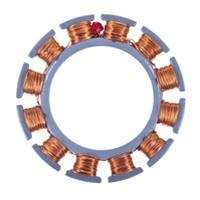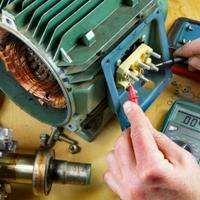How To Test A 2 Wire Stator With A Multimeter
Are you interested in knowing "how to examination a stator with a multimeter?" Whenever your vehicle cannot kickoff, there is a weak ignition, or the bombardment is non charging, maybe due to a faulty stator.
A faulty stator will not produce enough current, or the electric current is non reaching the battery or ignition box due to damaged wiring or a brusque circuit. You have to inspect the stator and wiring to figure out the problem.
If the stator seems to be fine visually, you need to execute some tests on the stator with a multimeter. For this purpose, yous should know how to examination a stator with a multimeter.
In this mail, we'll discuss testing a stator using a multimeter to make up one's mind whatever fault causing poor performance in your ATV, scooter, or 3-stage engine. But before testing, you lot must know what a stator is and how information technology works.
What is a Stator?
A stator is the stationary or fixed component of an electric motor or generator that lies inside the engine case, and a rotor spins inside information technology.
The stator consists of 3 parts. An outer frame protects the stator cadre and the winding. Stator winding is attached to the punching of the stator core.
iii-phase power is supplied to the stator winding and so that a rotating magnetic field is produced with the help of a rotor magnet, and the stator core carries this magnetic field. A stator winding is made powerful to conduct heavy current, and insulation is made exterior to prevent current period.
What does a stator do?
When electric current is supplied to the stator winding, an electromagnetic field is produced due to the continuously moving magnet of the rotor part.
A constantly changing magnetic field creates an electromagnetic strength (EMF) due to the phenomena of electromagnetic induction (varying magnetic field) in the current-carrying conductor. The EMF or Air conditioning voltage is converted to DC and is utilized in the motor.
The general working of all stators is the same. The purpose of installation may vary from motors to generators and Vehicles. In motorcycles and vehicles, the electric current produced in the stator charges the bombardment and generates ability to fire the spark plug to help ignition.
How to Test a Stator with a Multimeter?
This lesson volition work if you ain a motorcycle, ATV, or scooter. Grab your multimeter and follow the guide.
-
Testing a Stator Out of Engine
This test is carried out while the stator is out of the engine and all wirings are dispatched.
Nosotros'll perform several tests to determine whatsoever error in the output, ignition wires, and pick-up coil.
Short circuit Test
- Catch the yellowish wires grouped separately. The iii yellowish output wires charge the bombardment; that's why it's said to be a 3 phase stator. A low-powered engine contains 2 stage stator.
- Don't utilize light-green and blue wire, as they are for ignition. As well, the green and yellow wires should not connect to each other.
- To check if the current is brusk-circuited into the stator or cycle body, connect one probe to yellow wires and the other to the stator body.
- If there is no continuity, you will get OL or 1 reading on the multimeter, indicating an open loop or no electric current menses.
- However, if the stator is curt-circuited, the multimeter will show you 0 in the continuity test or the resistance in the Ohm fashion, which means that the current is passing somewhere.
This is how you test a brusk circuit in a stator. And also, test for whatever short circuit between ignition and output wires.
- Bank check all the xanthous (output-battery) wires with the green and blue (ignition) wires to inspect short circuits.
- Your multimeter must read 1 or OL while testing the blue and green with yellows.
- It indicates no connectedness between the ignition (blue, green) and the charging wires (yellow).
- If they are connecting each other, it may cause the stator to burn down due to a short excursion.
Resistance Test in output wires
After you lot have ensured there is no short circuit, check output wires to come across if they accept the same resistance.
- For this purpose, insert black and red probes in all the yellow wires.
- You will get three readings by inserting probes in the 1st and second wire, the 2nd and 3rd, and the 3rd and 1st.
- The purpose is to bank check the same resistance in all the wires, and all 3 phases should have the aforementioned reading.
- As well, test both ignition wires, and the resistance must exist in the range of that particular stator.
Pick upwardly coil test
A Choice-up coil is used in the ignition system of vehicles. It generates a voltage pulse carried as RPM to the ignition module.
You must also test the pickup coil to see if its reading is in range.
- Place the blackness probe in the blue wire plug and the crimson probe in the basis metal of the pickup roll.
- The measured reading of the pickup gyre, besides known as SPEC, must be in the range of that specific stator used in your motorbike.
- You can check that range in the transmission or find it online.
-
Static Stator Test
A static stator exam is washed when your vehicle is turned off. When you face a problem with the battery charging or the ignition, you lot tin do this test while the stator is on the bicycle.
Pick up your multimeter and follow these steps.
Resistance Examination
- Whether your bicycle has ii or three-stage stators, attach the probes of the multimeter to stage ane and stage 2, selecting the ohm setting on the multimeter.
- In a three-stage stator test, connect the probe with 2 phases and get 3 readings with two dissimilar wires every time.
- For a perfectly working stator, information technology's necessary to mensurate the aforementioned resistance through all output wires, whatever the reading is. Information technology means that all the cables are working with the same resistance. Otherwise, your stator is having problems while charging the batteries.
- Also, notation that a perfectly working output wire should have a .iii to .v ohm reading; otherwise, it could be a faulty stator.
Voltage and Continuity Examination
- While measuring AC voltage on a switched-off engine, the multimeter will show 0V on all phases of output wires. Information technology's considering no power is generated in the stator at that time. This is how to test a stator output.
- To check continuity in output wires, test all phases with each other. If the multimeter shows i or OL, there is no continuity, and any of the stator components are not working, causing a cleaved excursion path.
When a vehicle is off, information technology's non efficient for a consummate voltage exam as the engine is off, and yous can't examination the change in voltages. For this objective, nosotros follow a dynamic stator examination.
-
Dynamic Stator Examination
The dynamic stator test is carried out when your vehicle is switched on. In a dynamic stator test, the output wires' voltage is compared to ensure the engine goes well with the battery.
Voltage test when the vehicle is switched on
- Before you take switched on the bike, the Air conditioning voltage reading in all phases must be zero. There is no current due to the vehicle existence powered off.
- Now turn on the switch, and you must see the voltage modify. Its limit must be in the limit of your stators model.
- Increase throttle or rev upwardly the engine then that the stator increases the amount of voltage in the output wires.
- Readings on all three wire combinations must render the same output, and voltage should increase with the increasing RPM.
- It could be a mistake if y'all notice a significant difference in the reading. Also, no voltage means a failed stator.
Ignition Exam
- To cheque the ignition and spark plug of bikes with a multimeter, put one probe to the basis wire from the stator and the other probe to the wire going to the ignition box.
- So if at that place is a fault, your multimeter volition show 1 or relatively high resistance, meaning there is faulty wiring or stator.
By this test, you can check if the stator is giving enough ability to the ignition box or if there is a fault in the ignition wiring or the stator itself.
FAQs
What is a bad stator symbol in a motorcycle?
A bad stator on a motorcycle volition bear on the ignition, produce a weak electric spark, and the bike may not first. The battery volition not fully charge, causing dim lights and poor functioning of accessories that depend on the battery.
How to test a stator on a Kawasaki engine?
A Kawasaki engine is built of a 3-phase stator. If the battery is not charging well, y'all must check all phases with each other for a voltage and continuity exam.
Attach probes to a to b, b to c, and c to a. Multimeter should read 12–25VAC output if the stator works perfectly in all phases, and voltage should increase with RPM.
A significant voltage difference in any phase indicates a poor connection or faulty stator, leading to battery charging issues.
You can follow the detailed guide above to do a spark plug or ignition examination.
How to exam a stator without a multimeter?
Without a multimeter, yous can inspect only meaning defects in a stator. If the stator or wiring is burnt, you can figure it out visually. In such cases, the multimeter has no use.
Still, for a detailed complication assessment, you need a multimeter to bank check voltage, resistance, continuity, and a short circuit.
Conclusion
In this postal service, we discussed how to test a stator with a multimeter to examine any possible fault. Taking the stator out of the engine every fourth dimension is not suitable, but information technology gives you the most reliable results. You can practice it yourself if you have a multimeter and understand how to operate with engine wiring.
Using a multimeter, you lot can perform resistance, continuity, voltage, and pickup roll tests to know which stator component is not working efficiently. Hopefully, this guide volition assistance you configure your bike stator errors.
Related Guides:
-
What is the Symbol for Microfarads on a Multimeter?
-
What Does OL Hateful On a Multimeter?
Source: https://mrfixitca.com/how-to-test-a-stator-with-a-multimeter/

0 Response to "How To Test A 2 Wire Stator With A Multimeter"
Post a Comment